Concretely Speaking: Musings on Preferred Road Surfaces
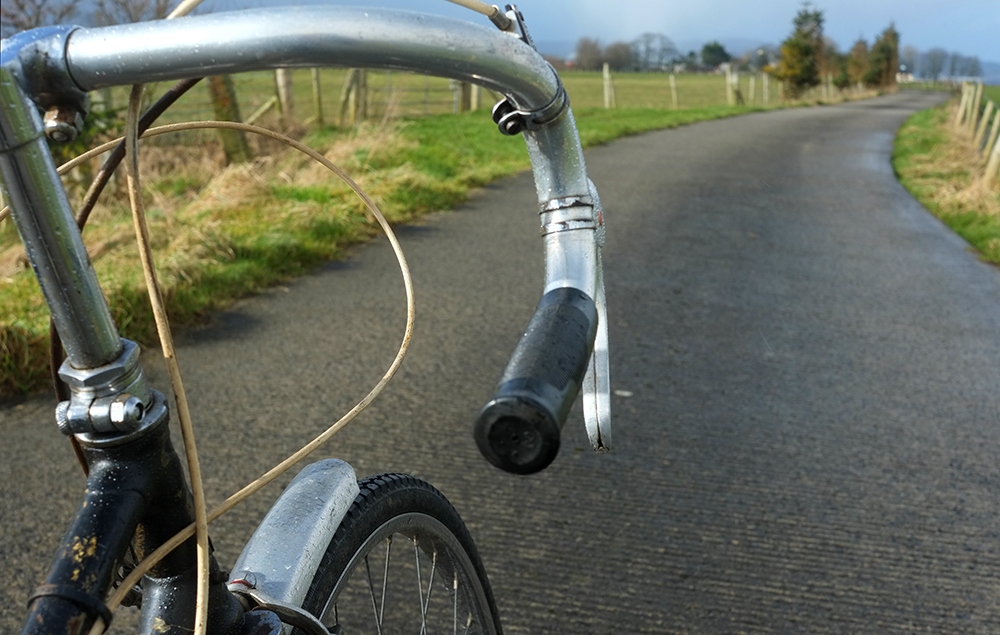
The house I live in stands at the end of a .7 mile farm lane that winds its way through fields of grazing cattle. Thus being the first and last leg of any journey I embark on, this lane - with its lack of traffic and nice scenery - has served as a backdrop for many of my bike photos. Funny enough, the thing that consistently interests readers about the photos I take here is not the scenery but the road surface. What is that stripey stuff and what's it like to ride on? Ah, what indeed! Well, instead of explaining again and again, I thought I would write a post addressing the matter concretely. Got the hint yet?
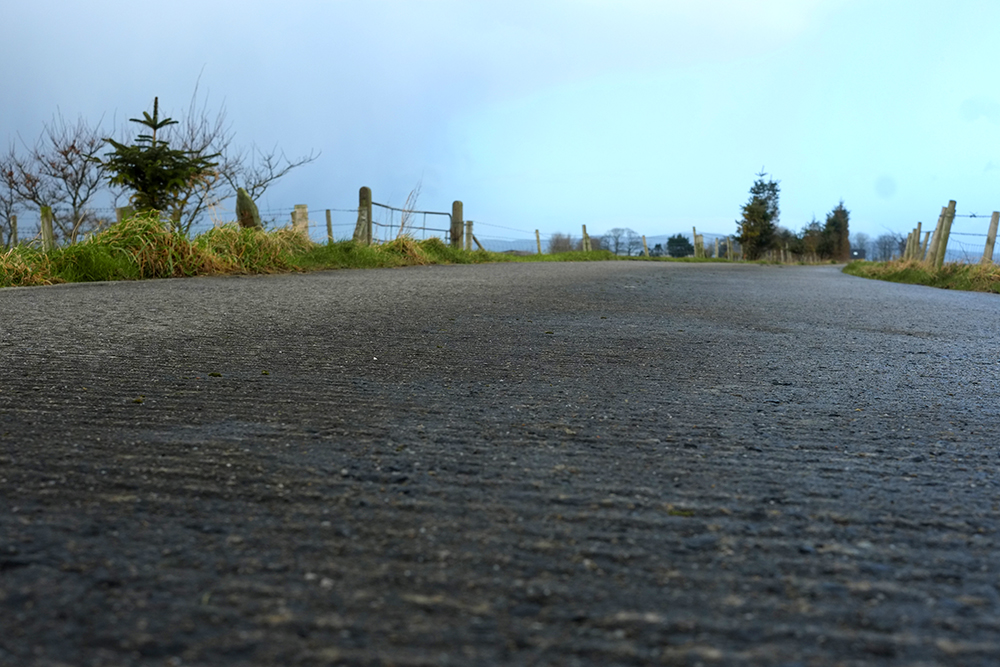
The road surface you see here is what is known as tined concrete. To create the stripey-texture effect, concrete is poured, then gone over with a rake-like implement (like so). The main reason for the use of concrete on lanes like this is that it's long wearing. Heavy farm machinery is hard on traditional pavement and chipseal surfaces. Dirt and gravel can become impassable after heavy rains. In comparison, concrete is long lasting and reliable.
What the tined surface treatment does, is improve traction in wet conditions. It has other functions too, such as muffling road noise, but the traction is really the main reason it's used around here. The local farm lanes tend to be very narrow and winding, with deep drops into water-filled ravines to both sides. Losing traction in the rain or on tractor oil residue is, frankly, undesirable - especially for the enormous tanker trucks that come to collect milk and vehicles of similar size.
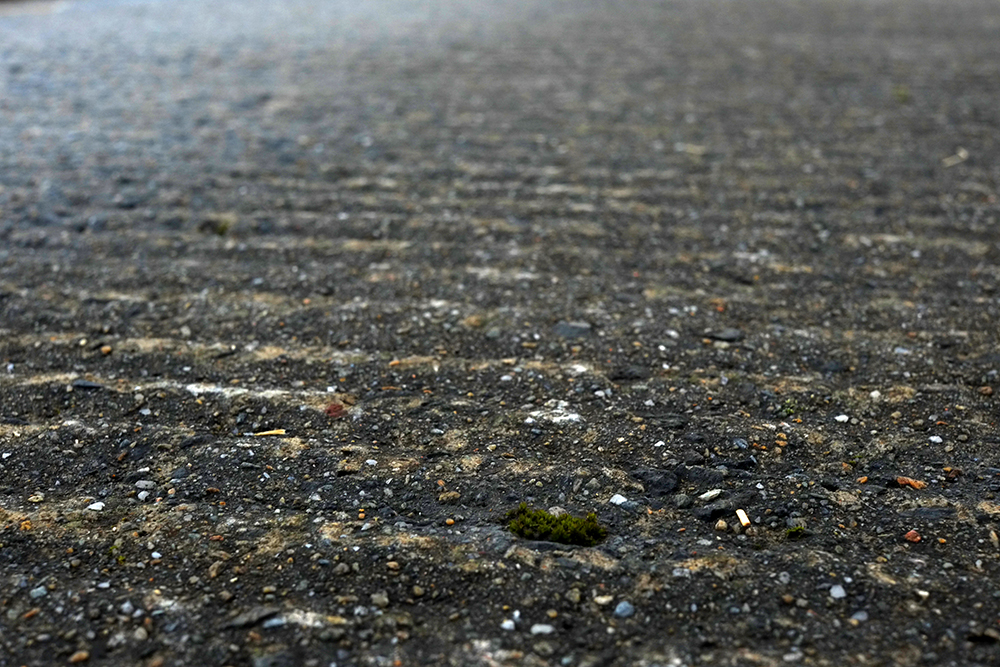
The grippy surface texture is also appreciable on the bicycle - allowing me to corner in the rain without slowing down too much. And despite its washboard appearance, this surface does not cause too much jitter or road buzz - though, of course, it helps that my bicycles are immune to that anyway.
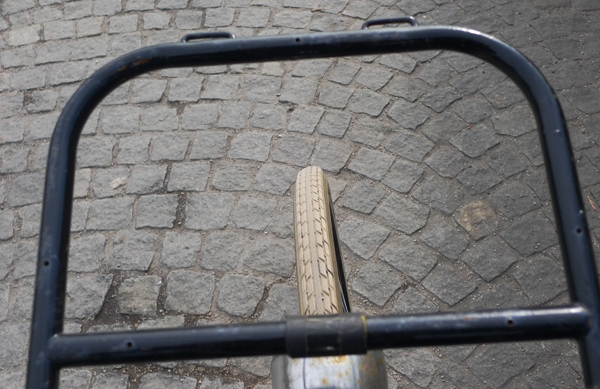 Examining the tined concrete groves (literally - whilst I laid on my stomach taking photos) made me recall other non-standard road surfaces I've encountered over the years. My favourite of these is probably cobblestones. In Vienna quite a few city streets are sett and cobblestone paved, and on the right bike they were a blast to navigate - so civilised and quaint in appearance, but in reality rough-edged, bouncy and unpredictable. I rode a lively low-trail vintage city bike with fat tires there, and it was just lovely. I would love to ride longer distances on pavé rural roads in France or Belgium some day.
Examining the tined concrete groves (literally - whilst I laid on my stomach taking photos) made me recall other non-standard road surfaces I've encountered over the years. My favourite of these is probably cobblestones. In Vienna quite a few city streets are sett and cobblestone paved, and on the right bike they were a blast to navigate - so civilised and quaint in appearance, but in reality rough-edged, bouncy and unpredictable. I rode a lively low-trail vintage city bike with fat tires there, and it was just lovely. I would love to ride longer distances on pavé rural roads in France or Belgium some day.As for my least favourite road surface, that would definitely be brick. It's not very common, but on occasion I do encounter stretches of city streets and even dedicated bicycle paths that are surfaced in brick, and the problem is that - even in the best conditions - they tend to be treacherously slippery. One of the few times I've come close to "wiping out" on my bike, was on a brick path in some very mild drizzle. If at all possible, I try to avoid this surface.
The smooth pavement of New England roads used to feel like a neutral surface to me. But now the new neutral is the rougher chipseal tarmac of Northern Ireland - so that when I first go cycling in the US on one of my visits back, the pavement there feels unnaturally smooth and a bit slippery. It's also a boost to my self esteem, since on American roads I am noticeable faster!
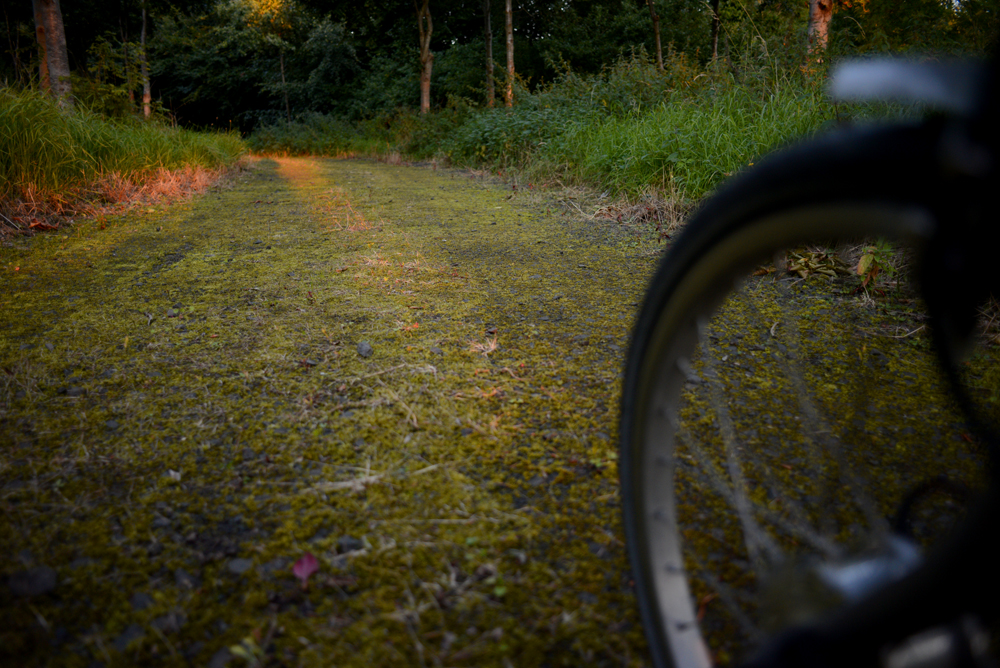
And then of course there is the rough stuff. My unpaved preferences lean toward packed dirt, rather than gravel, my favourite being when the soil is heavy in clay content, like in some parts of Vermont. And as far as my least favourite... I am not a huge fan of deep mud, rough roots, or deep sand, despite being better at handling them than I once was. But nothing has the power to get me off my bike like extreme washboard. And I'm not talking about shallow ripples here, but the kind that are a foot tall. When I first encountered this phenomenon, I did not even think it was possible to cycle over such a surface. And yet my companions proceeded to do just that in a kind of slow hopping motion, as I walked my bike beside them after several failed attempts!
I am blessed with many types of road surfaces where I now live. When I turn off onto an unexplored lane, I never quite know what awaits me there - tarmac, chipseal, concrete, dirt, or moss-covered stone. Some of these textures I like better than others, but the variety in itself is part of the fun. What are the roads like in your neck of the woods, and what are your preferences?

I couldn't agree with you more about how much I love riding on packed dirt, especially that with high clay content. Parts of the Catskills are situated on the Marcellus Shale, which gives the dirt roads their characterstic "red clay" appearance. It packs very well with moisture (see https://flic.kr/p/f8XfhH), making it smoother than pavement, but when very dry causes huge plumes of fine red dust when vehicles drive fast on it.
ReplyDeleteI have not been to the areas with the red clay roads, only white. Would love to visit there.
DeleteQuestion is though ...do my Hetres need to match?
On our red clay roads when things finally dry out in the spring it doesn't matter what color ANYTHING is, soon enough it will match. There have been times where my friends and I have looked like those Chinese Terracotta tomb guards, at least from the waist down. I have an infinity of dusty pink socks that used to be white that no amount of hot water and bleach seem to be able to restore...
DeleteSpindizzy
This post is making me think about how much I'm hating the snow and ice right now.
DeleteThis morning I would cheerfully ride on any amount of chipseal, rutted gravel, packed dirt, hickory planks, corn flakes, I don't care as long as it's not glazed with ice and frozen car snot. Get me away from here and the lightly buttered Teflon on the road in front of my house, the encyclopedia sized slabs of frozen car-cake glued to the road like autumn leaves and the rotted drifts of ice and gravel that start at the fog-line and stop halfway up the fenceposts. There is a man-shaped, man-sized chunk of something in a big black trash bag poking out of a drift the snowplow left by the railroad tracks at the bottom of the hill behind my house that's been there since the middle of January. At first I thought it was a rug but in my mind it's become a metaphor for last years unachieved goals and broken promises, left un-buried by people overcome with adversity and cold and now frozen solid till time and sunshine melt it away as a gracious gesture from the world to that ever forgetful and ungrateful population. It probably is just a rug but it creeps me out to ride by it all the same...
Spindizzy
Anything but the path with gazillions of roots like this one: http://bostonbybike.blogspot.com/2014/09/brakes-compared-trp-cx9-and-tektro-cr720.html
ReplyDeleteOh, and the icy bike paths such as the Minuteman in Arlington this week. Apparently, DPW in Arlington thinks that plowing the Minuteman twice this winter is enough.
On Paris Brest Paris you will find a lot of small roads with not very smooth surfaces. So your daily trips are a good training for this and you won't be disturbed or frustrated in France (as some other riders are).
ReplyDeleteBefore starting in 2011 I had spent 3 weeks in Hungary and had done many trainings on poor roads. Afterwards on PBP I was happy to find better roads. This is mentally easier to handle, will do the same this year.
Well, my current local roads are Boston, so you already covered that.
ReplyDeleteMy least favorite, probably, was the sort of tar-and-chip I haven't run across up here, where there's so much tar it pools in the summer, and if you don't have fenders, is molten enough to splatter permanent black blots everywhere. And to make a little click-snap-click-snap noise as tiny strings of it attach and snap like chewing gum on a sole, constantly. Yuck.
We had the same sort of hard-clay dirt in Ohio as Vermont, and I like it both places. (The dirt if un-processed is about the same consistency; we didn't have any of the well-graded and processed roads like Vermont around me; it was all terrible tar and chip for cheap roads in the countryside.)
I like stone-dust over well-packed earth for MUPs; it's much more jogger-friendly than pavement, and almost as nice on a bike; But only if it's well-graded. Most of the dirt railtrails up here are designed more for runners and snowmobiles, and a road bike will suffer. (Rideable, certainly, but you can't bomb down it. Or at least I can't.)
Re the tar, something sort of similar happens here. In the summer, it sometimes gets hot enough for the tar to melt and liquify, so that the road surface sticks to your tires and comes out in clumps, then pelting your entire bike with bits of molten tar. On one occasion, I was headed home over a sun-fdrenched mountain at the end of a long ride, and had to pull over at the side of the road to scrape the stuff off, as my brakes were getting clogged as it solidified!
DeleteToo much clay content = glue.
ReplyDeleteSiping on the road vs. tire must be considered. One's choice of the latter is determined by the former. High friction in the dry can mean the opposite in the wet, comparatively speaking.
This has been today's Yoda haiku.
my least favorite surface is pot-holed and crumbled pavement, which unfortunately are many of the roads around here. looks like that "stripey stuff" would be chattery.
ReplyDeleteI'm a bit of a slow study, but I think I'm finally understanding your link between bicycling and photography - and why both "click" (pun intended) with you. It relates to perception.
ReplyDeleteI strongly suspect that no driver of an auto would take nearly the same interest over what they traverse. Similarly, autos are renowned for getting you from place A to B, with little understanding of the journey or points between. With bicycles, very often the journey itself is "the thing" - that one perceives and appreciates
Photography has many implications and ramifications, but all these start from the point of visual perception. Not so surprising, then, how they go together.
Now if I could just find a connection linking all of this with Martin's and beer........
One thing I have become aware of since moving here is that photography for me is a very physical thing. Walking knee-deep through bogland in fog to photograph a pile or rocks than no one cares about but me, and to come back many times until I get it looking Just So... somehow this physicality ends up reflected in the end result, and that is what I like about the photo.
DeleteUnless it's after a very intense bike ride, I am not an enthusiastic beer drinker. A properly made martini though tastes incredible and does something to the mind. I will forgive it, even if it bears no connection to cycling.
Sensible, thank you for your reply, Your post on the martini a while ago inspired a birthday present for my wife (kit, shaker and a bit of research on my part). She enjoys them (every now and then, in moderation).
DeleteMy town believes in "chip seal" (oil the road, press stones in the oil and let it bond) on the less well traveled roads every two years as an alternative to repairing/replacing the asphalt correctly as a way to save money. Takes a nice fast, if not a little crumbly surface and makes it like riding in marshmallow fluff for 6 months till it's compacted down all the way.
ReplyDeleteI spent part of my summer vacation in the Adirondack State Park riding on some fantastic dirt road- hard packed and fast in the corners. Wonderful stuff to be on with slick 700x26 tires, zero flats and speeds faster than the local asphalt.
Then I went to Vermont in September and climbed the Arlington-Stratton road on one of the first days it was open to the public again (Hurricane Irene destroyed it along large swaths of Vermont). What a helllish nightmare of soft, deep dirt and gravel... I finished the climb and connected with some side roads to get me back to Jamaica State Park and found myself on some fantasticlly fast dirt roads that more than made up for the climb.
I'm from Mallorca and some stretches of coastal bike paths are made of thick wooden slats that are very slippery when wet. However, I really like them.
ReplyDeleteYour blog is "mel d'abella coixa" (fantastic).
I really dislike riding on irregular blocks and chunks of ice, such as sometimes accumulate on the concrete cycle trails here in winter. Actually, ice in any form is not really a bicycle-friendly surface. Almost anything else is fine, I guess. It's kind of like hills or headwinds: I can't do anything about it, so might as well make the best of the conditions. One thing I've always wondered about, though: brick streets don't seem to get potholes to the extent that concrete or asphalt road surfaces do. Why is that?
ReplyDeleteDon't know about potholes, but bricks loosen up over time, with gaps and various instabilities forming. In one street in my old neighborhood in Boston, this happened pretty quickly after new brick was laid. Within months, some bricks were sticking out on their sides or at an angle, and others were floating loose, with gaps wide enough to swallow and jam up a bicycle wheel.
DeleteI encounter a variety of surfaces here - with a MTB (still think ATB is more accurate), most surfaces are fine, even those with a bit of challenge though the 'extreme washboard' does get tiring if it continues for too long - at the moment there are trees in some areas here dropping what we refer to as 'conkers', when you ride along a path scattered with these, your bike bounces around in all directions - such fun, I actively seek out 'conker zones' . I enjoy dirt bush trails, river sand tracks, riding over fallen leaves in autumn and pebbly surfaces - all make an interesting change from typical bitumen roads
ReplyDeleteThanks for the link to your Vienna posts. I read through them all, surprised to find they go back to 2009!
ReplyDeleteYup. The Vienna posts go back to 2009, because I was still living there full time when I started Lovely Bicycle (though getting ready to return to Boston). I then continued to return to Vienna for month-long stretches at a time for work on a regular basis, until early 2012.
DeleteCrushed limestone is common on many trails here in the U.S. Midwest.
ReplyDeleteDry it makes for pleasant riding. Decent traction and enough give I never have to worry about my fillings.
Wet traction is not bad. The problem is smaller limestone particles when wet adhere most effectively to the fenders, the tubing, and the moving parts (including the rider) and is quite the challenge to clean off.
In my community, several busy intersections have been resurfaced with ribbed concrete. It makes a longer lasting replacement for traditional asphalt, which tends to get rutted, especially when heavy trucks roll over it during hot weather. On unpaved trails, packed dirt can be a forgiving ride, as others have said. But I recall destroying my drivetrain during my very first mountain bike race back in the 80s. It had rained the night before, and the course became a quagmire of greasy bentonite mud, which the locals called gumbo. I was among four or five riders who had to hitch back to the starting line. I remember my mud-clogged rear derailleur wrapping itself around the cogs. Not a pretty sight.
ReplyDeletewe have few roads around here with very unpleasant surface: concrete pannel blocks, and every cca three meteres there is few cm wide gap or trench, so while riding You get every few seconds one hit to hands and immediately second hit to butt.
ReplyDeleteI was noticing a few days ago on a new overpass that the top part had concrete just like this. I imagine it's to help with grip when there's frost.
ReplyDeleteWhat kind of bike is this? It appears to be a vintage three speed.
ReplyDeleteIt's a 1930s Claud Butler mixte, with a 4-speed Sturmey Archer hub
DeleteI am not familiar with tined concrete. Looks like a crappy road surface for bikes, to me...and not something one would like in Canada with many areas that tend to be icy and snowy for a significant number of months annually.
ReplyDeleteChipseal is awful and just find it unnecessary since slows down cycling ...even on a recreational path.
I rode on cobblestones yesterday, that was fun. 25 kilometers of cobblestones.
ReplyDeleteActually I had to deflate front tyre a bit to get rid of the vibration.
With a fat tires it is comfortable enough.
The most preferable surface for me is good gravel, in dry conditions. I think it is a little boring to ride on good asphalt roads all the time.